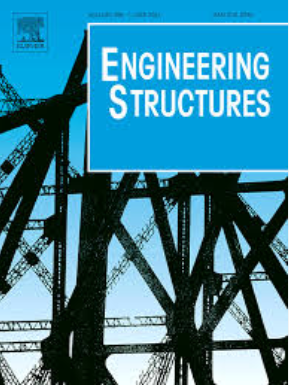Fire resistance of ultra-high performance concrete-filled steel tubes slender columns at different concrete ages: Experimental and theoretical investigation
IF 6.4
1区 工程技术
Q1 ENGINEERING, CIVIL
引用次数: 0
Abstract
Fire-related accidents are more frequent during the construction phase, posing serious risks to building structures, which can result in material damage, construction delays, and significant safety hazards. This paper investigates the fire-resistance performance of ultra-high performance concrete-filled steel tube (UHPCFST) slender columns at different curing ages of UHPC to simulate the occurrence of fire scenarios during construction phase. The fire-resistance tests were conducted on 10 full-scale UHPCFST slender columns subjected to the ISO-834 standard fire to investigate the effect of UHPC age and load ratio on the thermal and mechanical response of the UHPCFST columns at different early ages. The results indicate that the fire-resistance time of UHPCFST slender columns decreases as UHPC age increases, particularly in specimens with a 0.3 load ratio, where the age at 56 days was 148 % lower than at 3 days. Furthermore, based on the average temperature method, a predictive model for determining the fire-resistance bearing capacity of early-age UHPCFST slender columns was proposed and validated. This research provides valuable insights for fire safety design and structural reliability assessment of UHPCFST structures during the construction phase.
不同混凝土龄期下超高性能钢管混凝土细长柱的耐火性能:试验与理论研究
与火灾有关的事故在施工阶段更为频繁,对建筑结构构成严重风险,可能导致材料损坏、施工延误和重大安全隐患。本文研究了超高性能钢管混凝土(UHPCFST)细长柱在不同养护龄期的耐火性能,模拟了施工阶段火灾场景的发生。采用ISO-834标准火种对10根UHPCFST细柱进行了耐火试验,研究了不同龄期和载荷比对UHPCFST细柱热力学响应的影响。结果表明:UHPCFST细长柱的耐火时间随着UHPC龄期的增加而缩短,特别是在荷载比为0.3的试件中,56 d龄期比3 d龄期缩短了148 %;在此基础上,基于平均温度法,建立了早期UHPCFST细长柱耐火承载力的预测模型,并进行了验证。本研究为超高压砼砼结构施工阶段的消防安全设计和结构可靠度评估提供了有价值的见解。
本文章由计算机程序翻译,如有差异,请以英文原文为准。
求助全文
约1分钟内获得全文
求助全文
来源期刊

Engineering Structures
工程技术-工程:土木
CiteScore
10.20
自引率
14.50%
发文量
1385
审稿时长
67 days
期刊介绍:
Engineering Structures provides a forum for a broad blend of scientific and technical papers to reflect the evolving needs of the structural engineering and structural mechanics communities. Particularly welcome are contributions dealing with applications of structural engineering and mechanics principles in all areas of technology. The journal aspires to a broad and integrated coverage of the effects of dynamic loadings and of the modelling techniques whereby the structural response to these loadings may be computed.
The scope of Engineering Structures encompasses, but is not restricted to, the following areas: infrastructure engineering; earthquake engineering; structure-fluid-soil interaction; wind engineering; fire engineering; blast engineering; structural reliability/stability; life assessment/integrity; structural health monitoring; multi-hazard engineering; structural dynamics; optimization; expert systems; experimental modelling; performance-based design; multiscale analysis; value engineering.
Topics of interest include: tall buildings; innovative structures; environmentally responsive structures; bridges; stadiums; commercial and public buildings; transmission towers; television and telecommunication masts; foldable structures; cooling towers; plates and shells; suspension structures; protective structures; smart structures; nuclear reactors; dams; pressure vessels; pipelines; tunnels.
Engineering Structures also publishes review articles, short communications and discussions, book reviews, and a diary on international events related to any aspect of structural engineering.
 求助内容:
求助内容: 应助结果提醒方式:
应助结果提醒方式:


